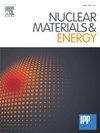Simulations of divertor designs that spatially separate power and particle exhaust using mid-leg divertor particle pumping
IF 2.3
2区 物理与天体物理
Q1 NUCLEAR SCIENCE & TECHNOLOGY
引用次数: 0
Abstract
Predictive design modeling of a Dissipation-Focused Divertor for future operation in DIII-D reveals that increasing the poloidal distance of the pump duct entrance from the target surface along the low-field side divertor baffle increases neutral compression and modifies the spatial distribution of power dissipation. With a divertor pump located mid-leg between the target and the X-point, SOLPS-ITER boundary plasma simulations without drifts predict the formation of a dense neutral cloud near the target with > 30x higher neutral compression in detachment, a more stable detachment front located further from the target, and ∼25% lower outer midplane separatrix density required for detachment onset, compared to a pump located in the scrape-off layer at the target surface. Up to 19 MW of power flowing into the divertors is modeled using the following two numerical implementations for particle pumping: a specified fraction of particles incident on variable wall sections of the plasma grid is removed from the computational domain (so-called albedo pumping), and a pump duct is modeled which includes dynamics of kinetic neutrals in the duct. The simulations show that the detachment front is located between the divertor target and the X-point and is relatively stable near the pump entrance, without a strong dependence on gas puff rate or injected power. The mid-leg pump design spatially separates the two primary functions of a divertor (power handling and particle exhaust), with the majority of power dissipation occurring near the target plate and particle exhaust taking place further upstream. The benefit of enhanced dissipation using mid-leg pumping comes at the cost of a higher outer midplane separatrix density for a given amount of particle injection.
求助全文
约1分钟内获得全文
求助全文
来源期刊

Nuclear Materials and Energy
Materials Science-Materials Science (miscellaneous)
CiteScore
3.70
自引率
15.40%
发文量
175
审稿时长
20 weeks
期刊介绍:
The open-access journal Nuclear Materials and Energy is devoted to the growing field of research for material application in the production of nuclear energy. Nuclear Materials and Energy publishes original research articles of up to 6 pages in length.
 求助内容:
求助内容: 应助结果提醒方式:
应助结果提醒方式:


